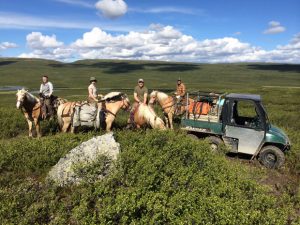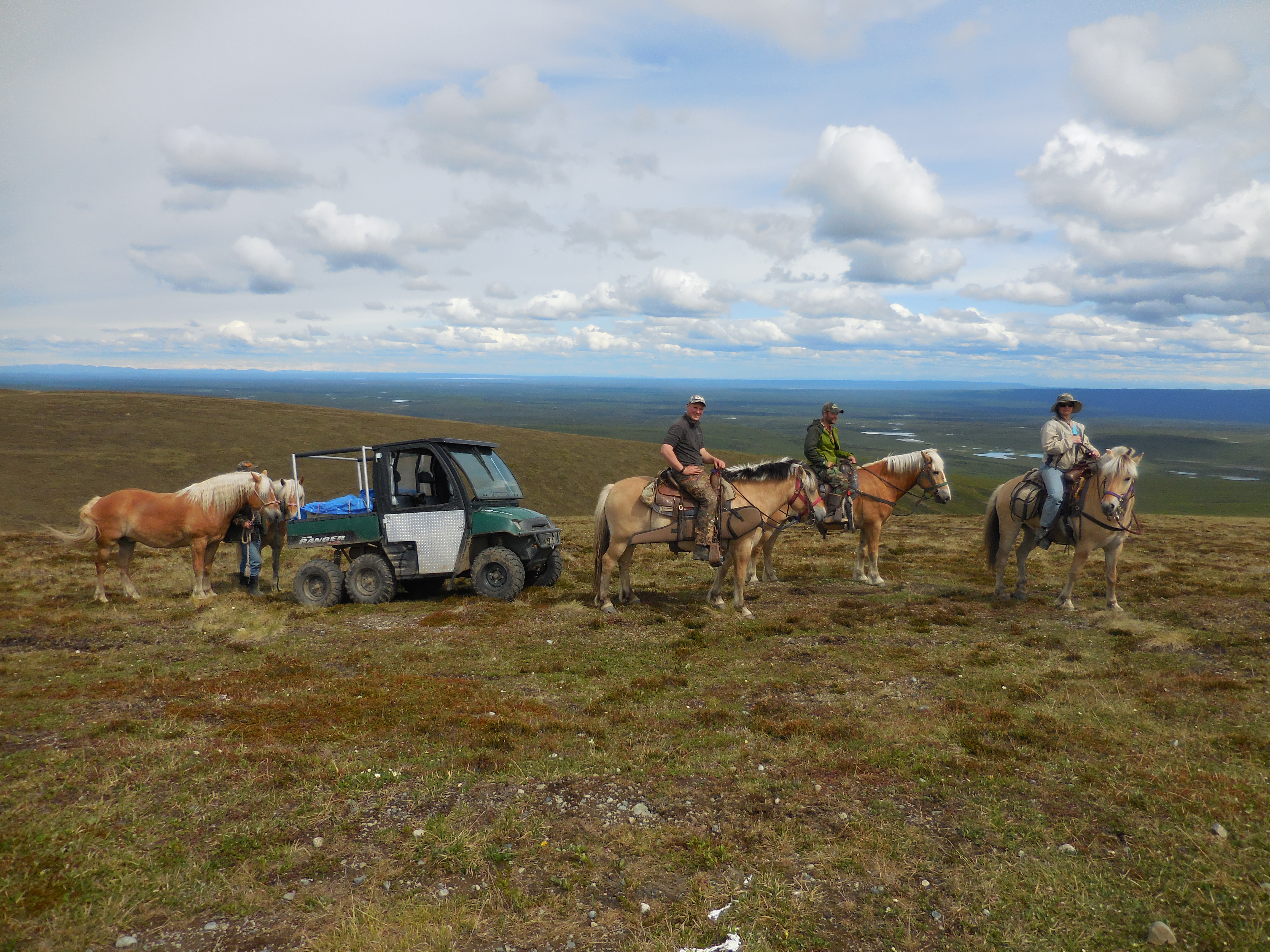
Recently I spent several days of trailing behind a string of horses on a Polaris Ranger 6×6 while exploring the Alaska backcountry near Eureka. We were searching for grizzlies and grayling in no certain order.
In my mind I was transported back in time to the late 1860s during the period of the great cattle drives of the American West. Cattle were driven by the thousands from Texas to places such as Colorado, New Mexico, Missouri and Kansas. A cattle drive consisted of approximately 2,000 head of cattle being driven thousands miles from the dry plains of Texas to the grasslands, stockyards and railroad hubs of the Midwest.
While the cattle walked about 15 miles a day, the cowboys endured the long, hard drive that spanned two months. They encountered dust, rattlesnakes, river crossings and thunderstorms that lead to tornadoes, stampedes and regrouping. The chuckwagon was invented out of necessity by a Texan named Charles Goodnight in 1866 for equipment that had to be carried along the trail. The chuckwagon was built to carry the essentials of the drive for cowboy and cattle alike, including medical supplies, tools, utensils, bedrolls, cookware, food, water, molasses and coffee. Condensed canned milk was finally invented by the Bordens in the early 1860s and used by the Union soldiers during the Civil War, though it was a luxury item for the cowboys during the later years of the cattle drives.
The chuckwagon was considered a home-away-from-home for two grueling months. A typical dinner next to the chuckwagon consisted of beans, cornbread and cowboy coffee cooked over the campfire with an occasional slice of beef, bacon or salt pork. The era of the chuckwagon cattle drive lasted only 20 years due to the advent of refrigerated railroad cars. The mystique of the Old West has been memorialized to this day in stories, reenactments, movies and photos.
The horses I trailed behind on the Eureka Trail also moved rather slowly, attracted mosquitos and created lots of dust. The modern-day chuckwagon I drove required neither leather harness hookups nor a bull whip. The similarities to the 1860s chuckwagon consisted of axle grease, an adventurous spirit, a cranky old cook in the driver seat and all the essentials for the Eureka trail ride loaded in the back. The Polaris Ranger 6×6 was equipped with cookware, coolers of food, a cook stove, horse tack, horse feed, tents, bedrolls, blankets, tools, medical supplies and water for horse riders and horses alike. The typical dinner around the campfire consisted of grilled hamburgers, beans and coffee with the occasional chocolate pudding, fruit cup or a glass of ice-cold milk.
There were no cattle to herd on the Eureka trip. The horses were being tested in the mountainous terrain of Alaska for an upcoming Brooks Range sheep hunt. The horses were getting some needed exercise and experience with a saddle and rider on their back. When encountering a grizzly bear on the trail the horses are trained not to panic. All we learned on this trip, however, is that they don’t panic at the sight of ptarmigan on the trail. Our modern-day cowboys carried rifles in their saddle scabbards since grizzly season was open. We also had fishing rods for the grayling hiding along the trail in the high and muddy river crossings. The rifles weren’t pulled from the scabbards since no grizzlies were spotted and the cast-iron skillet never had any fish to fry. Bad fisherman or bad water conditions kept the grayling off our hooks but the Alaska countryside was a rugged and beautiful.
 The horses practiced trotting and walking on rocky terrain, steep hills and the muddy, deep river crossings. The modern-day chuckwagon didn’t break apart during a boulder-filled river crossing and send all the supplies floating downriver like the old days of the chuckwagon crossing the Red River in Texas. The Polaris Ranger’s rubber wheels didn’t crack apart and fall off the axle on steep rocky terrain. The cranky old driver didn’t have to sit on a burlap sack full of cornmeal for a smoother ride on the bouncy trail. The modern-day chuckwagon worked hand-in-hand with the horses as they crossed the Alaska tundra, which has scenery that is as vast and remote as the Texas panhandle.
The horses practiced trotting and walking on rocky terrain, steep hills and the muddy, deep river crossings. The modern-day chuckwagon didn’t break apart during a boulder-filled river crossing and send all the supplies floating downriver like the old days of the chuckwagon crossing the Red River in Texas. The Polaris Ranger’s rubber wheels didn’t crack apart and fall off the axle on steep rocky terrain. The cranky old driver didn’t have to sit on a burlap sack full of cornmeal for a smoother ride on the bouncy trail. The modern-day chuckwagon worked hand-in-hand with the horses as they crossed the Alaska tundra, which has scenery that is as vast and remote as the Texas panhandle.
Resting and feeding the horses along the trail allows the riders to relax and enjoy the short, sunny Alaska summer. Fishing, napping, photography, writing and snacking was a welcome rest from the slow-moving, clip-clop sounds of the horses walking down the trail. Horseshoes often had to be replaced on a cattle drive and even in modern times the horses still rely on shoes to prevent injury in the rocky terrain of Alaska. The heavy chunk of metal called an anvil is still a farrier’s best friend. Cowboys would often use the rivers for a bath, drinking water or to cool down from the Texas heat and our Eureka riders were no different.
The great cattle drives of the Old West and the modern-day chuckwagon trail rides conjure up the feeling of exploration, freedom and the beauty of the United States. Texas is big but Alaska is bigger and I’m sure that had Texan Charles Goodnight been around today he would be exploring our Great Land. His chuckwagon would have been bigger and sturdier for the Alaska trails and it surely would have included snowshoes and bug spray in the essential equipment pile.
There is something about a horse and wagon that brings out the kid, the cowboy and the chuckwagon cook in all of us. The next time you’re crossing a raging river, sitting around a campfire or drinking a tin cup of hot cowboy coffee, your mind may wander off to the days of an old cattle drives. Savor the smell of the coffee, feel the adrenaline of the river crossing and soak in the warmth of the campfire. Raise your tin cup to the cowboys and drovers of the American West, douse the campfire and then release the brake on the chuckwagon. As the chuckwagon squeaks and rumbles towards a far off destination, take the time to breathe the fresh air of Alaska and marvel at the beauty of its landscape.
Jeff Sullivan has lived in Alaska for the past 25 years and enjoys writing stories about the people that live the Alaskan outdoor lifestyle and the places they explore. Jeff is an assistant Alaska guide, published writer and according to his granddaughter, the best hunter and fisherman in Alaska. Jeff can be reached at sullivan0823@gmail.com.
